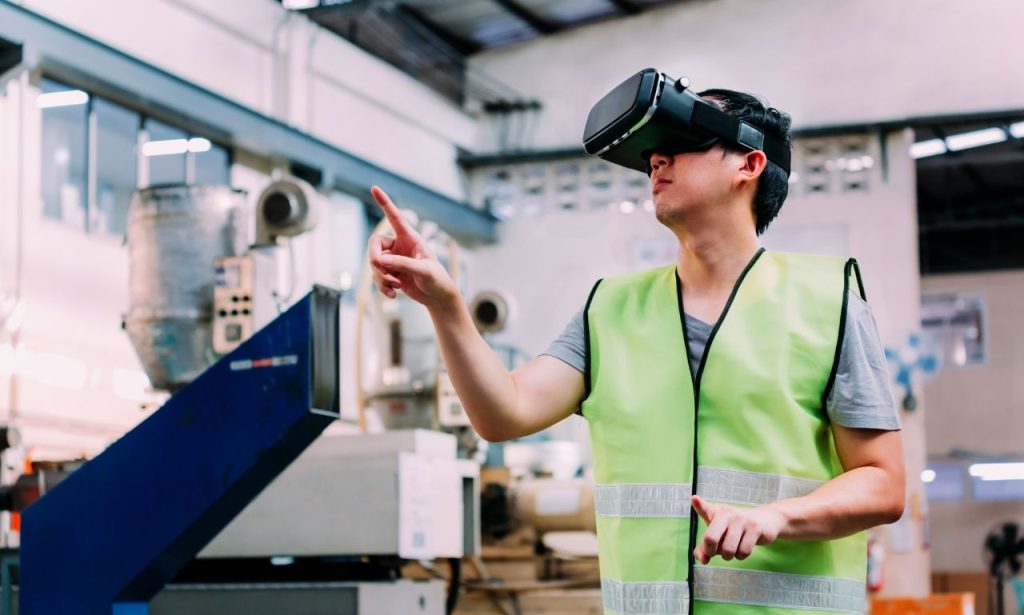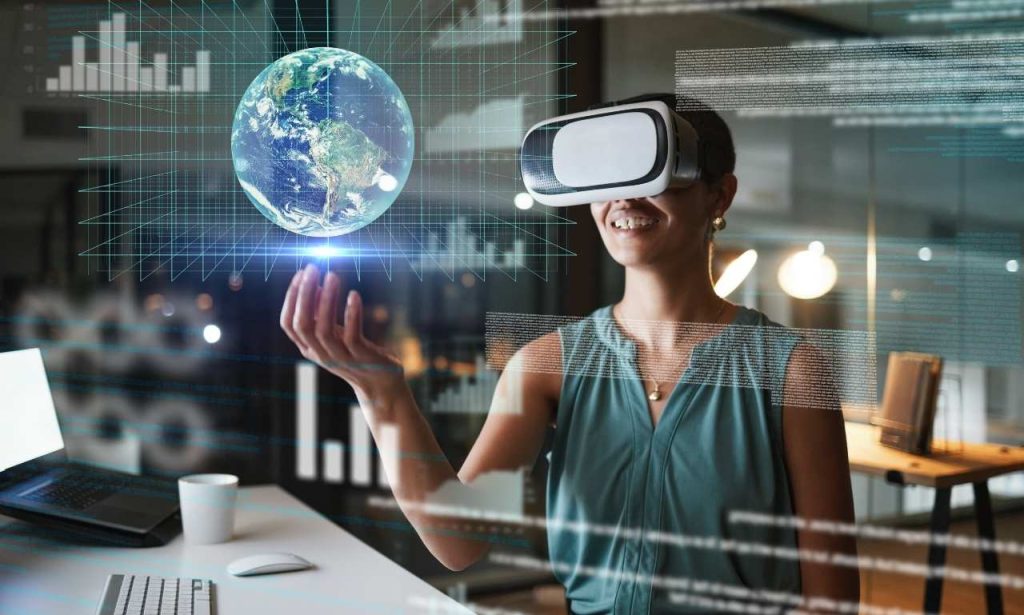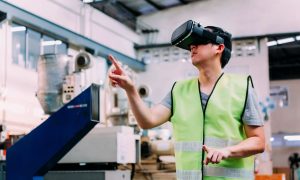Virtual reality has evolved from a gaming novelty to an essential business tool across industries. The technology now offers immersive experiences that create new possibilities for customer engagement and operational efficiency. Companies leverage VR to gain competitive advantages in increasingly digital marketplaces. Since 2016, VR has transformed dramatically. Today’s systems feature crisp graphics, natural interactions, and diverse applications. The technology now integrates with other emerging tools to create powerful business solutions. From healthcare to retail, VR is changing how companies operate through immersive training, virtual showrooms, and enhanced customer experiences. Let’s explore how virtual reality services are shaping industries.
The State of the AR/VR Market

The AR/VR market has grown remarkably, with a 35% compound annual growth rate since 2023. Global spending reached $75 billion in early 2025, reflecting significant industry expansion. North America leads with 42% of global spending, though Asia-Pacific regions are quickly gaining ground.
Enterprise applications now represent 65% of all VR implementations, shifting from consumer-focused uses. Manufacturing, healthcare, and education show the highest adoption rates. Market consolidation around key players has improved standardization and interoperability between systems.
Hardware costs have decreased by 40% compared to 2022, making VR accessible to smaller businesses. Improved development tools have also reduced software costs, lowering barriers to entry for companies wanting to implement virtual reality solutions.
AR and VR to Give You an Edge in 2025
VR offers measurable competitive advantages. Immersive experiences increase customer engagement, leading to 35% higher retention rates. Training programs in virtual environments reduce learning time by 60% while improving quality. Virtual showrooms have revolutionized retail, reducing product return rates by 25%.
Marketing campaigns gain new dimensions through VR experiences that conventional media cannot match. These immersive interactions generate 70% more social media shares than traditional campaigns, strengthening emotional connections with customers.
AI in AR/VR
AI integration with virtual reality creates powerful capabilities. Machine learning algorithms personalize experiences in real time based on user behavior. Computer vision helps VR systems understand the physical world, while natural language processing enables intuitive voice commands.
Predictive analytics helps businesses optimize their VR implementations by identifying popular features. AI-driven content creation tools make development more efficient, reducing production time and costs. These technologies enable new business models, including adaptive learning systems and intelligent virtual assistants.
Digital Avatars
Today’s Digital avatars possess lifelike features and communication abilities, resulting in better-quality interactions. Businesses that use avatars deliver continuous support to customers at all times. Organizations employing virtual personnel based on avatar technology measure a 40% growth in consumer contentment rates.
Healthcare professionals implement avatar technology to deliver therapy services and patient education, which helps patients feel more comfortable and adhere better to their medical treatments. The development of motion capture systems within avatar technology fetches better performance by creating more realistic,c natural expressions for virtual environments.
WebAR and Cross-Platform Apps
Users can engage with augmented reality experiences on their browsers through web-based augmented reality technology while omitting the need for specific applications. Web-based augmented reality increases the number of users who can access AR content. The implementation process becomes simpler through cross-platform development because it generates content on various devices and operating systems.
WebAR technology integrated into e-commerce platforms enables customers to see products within their environments before making purchasing decisions. The functionality enables first adopters to boost their conversion rates by 30%. AR applications accessible through multiple platforms have been accepted by educational institutions to make interactive learning more accessible to students.
Wearable AR/VR

The AR/VR industry experienced a transformation through wearable technology development. The latest generation of headsets weighs 65% less than their 2022 counterparts and delivers battery life that permits users to work for an entire day. Smart glasses have become popular in professional settings because they let workers obtain information without using their hands.
Haptic feedback technologies provide virtual users with touch-based perceptions, improving the effectiveness of simulated training programs. Healthcare wearables team up with VR technology for therapeutic needs by tracking movements through game-like exercises to enhance patient recovery results.
Gamification
Through gamification, businesses convert their normal operations into interactive virtual reality environments. Programs incorporating gamification elements enhance participant attendance to 45% compared to standard programs. Establishing virtual environments through customer loyalty programs enables participants to receive rewards through their activities, which builds a stronger emotional connection to the brand.
Training simulations implement game features that drive better employee understanding of materials as personnel competes to excel at specific competencies. Through gamified virtual reality, healthcare providers develop rehabilitation programs that enhance therapy participation by adding virtual challenges. Educational organizations use identical teaching methods for complex subject instruction.
Practical Applications of AR/VR Across Industries
The healthcare industry has adopted VR technology as an essential tool for both surgical operations practice and overall medical planning. The realistic simulations available to surgeons let them practice complicated procedures, resulting in higher patient safety without exposing patients to risks. Implementing AR technology at manufacturing facilities helps workers navigate assembly lines, improving their performance by 35% while cutting down training durations.
Online stores establish virtual exhibition areas to present products remotely to their audiences. The real estate industry lets clients examine properties through virtual property tours regardless of their physical location. Virtual tourism platforms developed by tourism companies present worldwide destinations to audiences, which boosts actual tourism demand while delivering substitute travel experiences.
Challenges of AR/VR Tech
Widened adoption remains limited because virtual reality technology needs to solve various hurdles that emerged from its quick development.
Data Privacy Considerations
Virtual reality platforms gather an unmatched volume of user information, including information about users’ eye and physical movements. All such acquired information must be safeguarded meticulously through comprehensive governance protocols and protocols about how collection methods work. EU regulatory authorities continue developing new regulations by adding data privacy laws to protect virtual reality user interactions.
Users need encrypted storage and security measures to safeguard the biometric data generated in VR sessions. Companies should let users remain anonymous during usage when available options exist to enable user control of their digital trails.
Performance and Connectivity
High-resolution graphics and interactive environments demand significant processing power and minimal latency. Users experience degraded connectivity during immersive sessions, particularly when their networks lack sufficient data transmission speed.
Edge computing has been developed to address user latency issues by positioning processing power nearer to end users. 5G networks enhance VR capabilities through their fast connection speeds, but their coverage areas are restricted. Cloud systems provide cheaper alternatives to on-site hardware systems, yet they function based on network stability.
Device Size
Extended VR usage becomes uncomfortable after users spend more than an hour wearing headsets because of their weight and size. The limited battery duration of VR equipment restricts mobility since users must rely on external power supplies to move freely. The storage capacity limitations create problems for content quality standards and variety options.
Adopting professional environments faces challenges because large headset designs create safety risks in workspaces. The development of miniaturization technology works to resolve size-related problems, which will eventually disappear.
Health Issues Due to Prolonged Use of Wearables
Using VR for an extended period can cause physical health issues, particularly in the eyes and neck muscles. Twenty percent of users develop motion sickness because their visual perception of movement does not match their physical state of immobility. Prolonged use of VR also raises social isolation risks because it could replace genuine social interactions.
During extended VR sessions, posture problems may develop when users stay in awkward positions. Ongoing research studies enable the development of forthcoming safety standards for appropriate VR deployment.
AR and VR Trends

Virtual reality continues to evolve because of multiple emerging patterns. Social VR platforms are gaining popularity because they enable virtual meetings and business networking functions. Haptic technology advances create more immersive experiences by allowing users to feel virtual objects with increasing realism.
AI integration is becoming more sophisticated, with digital characters exhibiting natural behaviors in adaptive environments. Cross-platform compatibility is becoming increasingly important as users expect consistent experiences across devices. Affordable enterprise solutions drive wider business adoption as costs decrease and ROI becomes clearer.
Conclusion
Virtual reality technology has moved from its original specialized status to an indispensable business tool serving multiple industrial sectors. Technological advancements in hardware and software components continue to solve VR technology’s challenges. Businesses must investigate present-day implementation possibilities through initial small-scale pilot programs for strategic advancement.
Virtual reality will advance human labor and lifestyle in 2025 by enabling novel ways for people to connect and discover experiences. Organizations that adopt these changes will succeed in the developing digital environment.
Also Read: Reasons to Choose a CRM System Over Manual Processes
FAQs
Healthcare, manufacturing, retail, real estate, and education show the highest ROI from VR technologies.
Entry-level business solutions start around $5,000, while enterprise-wide implementations range from $50,000 to $500,000.
VR creates risk-free environments for practicing complex tasks, reducing training time by 40-60% while improving retention.
VR systems collect extensive data, including eye tracking, movement patterns, and physiological responses, raising data protection concerns.
